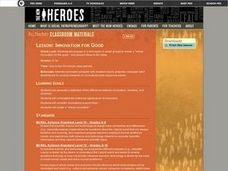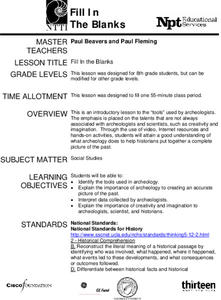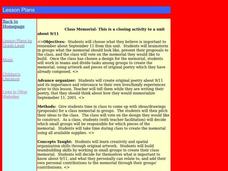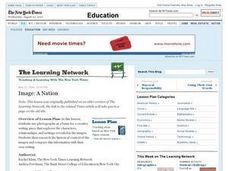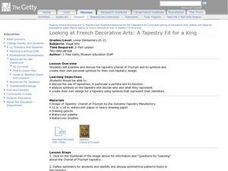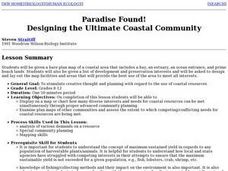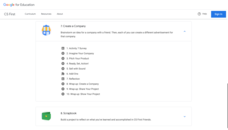Curated OER
Innovation for Good
Many historical innovations were created for the common good. Get your students ready for life as a critical thinker with this lesson plan which defines the differences between innovation and invention. They will conduct Internet...
Curated OER
Fill in the Blanks
Archaeologists, historians, and scientists all work together to create a timeline of our past. Engages learners in a series of activities that all filter through the NOVA video, "Mysteries of the First Americans." Each activity is...
Curated OER
Hazards: Fourth Grade Lesson Plans and Activities
Learn about damage associated with earthquakes and materials that best withstand a quake. A lab engages class members in the experimental design and construction of sturdy structures that can endure various earthquake...
J. Paul Getty Trust
Expressing Emotions through Art Lesson 1—Everyone Shows They Care
In a instructional activity that explores art and emotions, scholars analyze a piece of art and discuss which emotions it portrays. They go on to reflect on their own emotions and how they are similar to the feelings expressed...
Curated OER
Class Memorial
What is a memorial and what should it look like? Learners will choose what they believe is important to remember about September 11 and how it should be displayed. They work in groups and brainstorm details about the memorial and present...
Curated OER
Teach Ancient Greece!
“We alone regard a man who takes no interest in public affairs, not as a harmless but as a useless character.” Pericles’ comment, part of a funeral speech, sets the tone for a unit study of Ancient Greece. A series of activities...
J. Paul Getty Trust
Shaping Ideas: Symbolism in Sculpture—Lesson 3
The final session in a sequential, three-lesson plan sculpture study designed by the education staff of the J. Paul Getty Museum in Los Angeles has class members using the criterial they developed to critique each others' symbolic...
California Department of Education
My Dream Career
Is your job a dream come true? Career seekers research to discover what their ideal jobs might be in the second of five career and college readiness lessons for sixth graders. After determining their occupational clusters, individuals...
Curated OER
For Whom the Clock Strikes
How do the citizens of Polyglot celebrate New Year's Eve? Middle and high schoolers read about the history of the dropping ball on New Year's Eve, as well as the other holidays traditions that have gone by the wayside, before designing a...
Curated OER
The Causes and Course of the First World War
Use this twelve-day lesson plan to teach about the causes and courses of WWI. Each day scholars attend lectures, complete creative activities, and hold round table discussions on what they've learned. Web links and resources are...
Curated OER
Image: A Nation
Students use photographs as a basis for a creative writing piece that explores the characters, relationships, and settings revealed in the images.
Curated OER
Creative Can Sculptures Help Feed the Hungry
Students look at pictures of Canstruction sculptures, then read a news article about the construction of these canned food sculptures. In this current events lesson plan, the teacher introduces the article with pictures of winning...
Curated OER
Chariot of Triumph
Young scholars examine the tapestry "Chariot of Triumph." In this symbolism lesson, students analyze the symbols in the tapestry and what they represent. Young scholars create their own design for a tapestry by using various symbols that...
J. Paul Getty Trust
Looking and Learning in the Art Museum — Lesson 2
Is there a difference between examining an original work of art and viewing a reproduction? Class members are asked to reflect on this question after researching a piece, study a reproduction of it, and the examining the original in an...
American Psychological Association
Activities from the Society for the History of Psychology Website
The Society for the History of Psychology provides a list of teaching activities designed to acquaint learners with the various fields of psychology and introduce them to prominent psychologists. Details for several of the activities are...
Curated OER
Writing to See
Learners write descriptively and creatively after looking carefully at a work of art.
Curated OER
Creating a Coastal Area
Students design and lay out a map of a coastal area that includes a bay, an estuary, an ocean entrance, and prime beach lands. They write a plan outlining solutions to the economic problems of their community and present their map and...
Kansas Department for Aging and Disability Services
Leadership Activities
Implementing culture change within an existing organization begins with effective leadership. Scholars explore organizational leadership by reading and discussing case studies about nursing homes. They also write personal mission...
Curated OER
My Personal Improvement Plan
Students investigate what is necessary to design a personal improvement plan including making web using software. They research the meaning of Body Mass Index and how to measure it before accessing assigned web sites that discuss health...
Curated OER
Uncommon Americans
Students view a documentary called, Uncommon Americans, a special presentation of Biography, highlights the efforts of three extraordinary average citizens who have made a difference in their communities. Discussion and a creative...
J. Paul Getty Trust
Shaping Ideas: Symbolism in Sculpture—Lesson 2
Young artists create a series of sketches of ideas for a sculpture, and using the criteria develop in the previous class, critique their sketches. They then choose one of their ideas and create their work of art.
Google
Friends: Create a Company
Create a company, advertise it, and hope it grows. The seventh of eight parts in the Google CS First Friends unit challenges future business leaders to apply computer coding to create an advertisement for a company. After pairs come...
Curated OER
Who Polluted the River?
Study the impact of water pollution. A hands-on experiment and an interactive story about water pollution are the basis for the learning experience.
